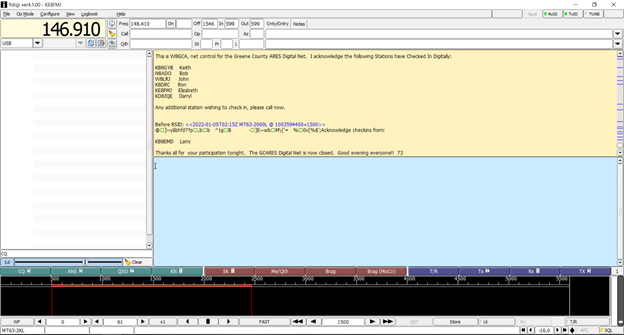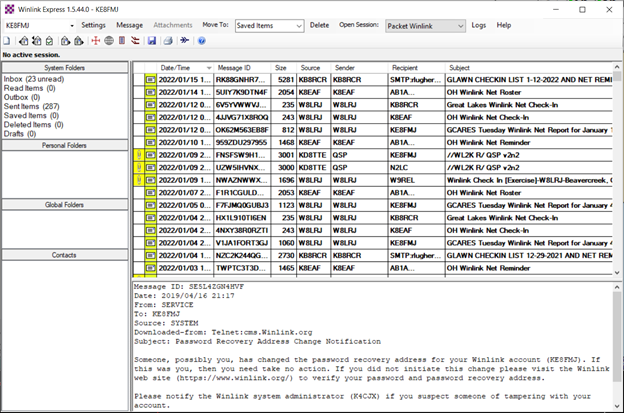Amateur Radio Emergency Services (ARES) supports and encourages the use of all communications modes to relay messages. This article aims to highlight a few digital modes. They are very accurate and effective at relaying complex and detailed messages that could be prone to error using other methods, and don’t bog down nets using voice mode.
Why Digital EMCOMM?
The needs of the community we serve during emergencies and disasters have changed. As hams, we now need to be able to send lists of evacuees in a format compatible with a spreadsheet, in addition to weather information, phone numbers of officials, inventories of required medical supplies, directions to an emergency operations center, and bulletins of critical situation updates. In other words, we need to be able to send data not suited to standard message forms, specifically voice. Imagine how long it would take to read a long list of evacuees or spell out phonetically a long list of pharmaceuticals if using phone.
As a result, amateur radio had to find a good way to send data. Unfortunately, many of the methods that hams use are impractical for some places, like very hilly areas with deep valleys that are difficult for VHF and UHF radio waves to traverse. In addition, some areas do not have much of a digital amateur radio infrastructure, and any solution would have to work well with weak signals and not require an extensive build.
One of the advantages of using digital modes is that they often utilize computer processing technology by linking the transceiver to a computer. One technique that is used for processing is called handshaking, where the transmitter sends data while the receiver acknowledges that it has arrived. In order to accomplish this, the transmitter sends a small group of characters. When checking that the data has been received, the receiver performs a parity check to make sure it has been received correctly.
Some systems employ more complicated forms of error detection and correction. Technology like forward error correction (FEC) may also be used. The concept behind FEC is that the sender encodes the message in a redundant way by using an error-correcting code. This redundancy allows the receiver to detect a limited number of errors that may occur anywhere in the message and often enables the receiver to correct these errors without needing a reverse channel to request re-transmission of data, but at the cost of a fixed, higher forward channel bandwidth.
NBEMS—a Digital EMCOMM Tool
Narrow Band Emergency Messaging System (NBEMS), using FLDIGI, FLMSG, FLAMP, FLWRAP and other programs, is a popular open-source software suite that is highly effective in emergency communications when used properly. There are dozens of modes that can be used with NBEMS, including MT63, PSK-31, MFSK, Olivia, RTTY, DominoEX, and many more. You’ll find information on NBEMS here.
MT63
After several years of experimentation, amateur radio found a mode that would work well on UHF and VHF. MT63, developed by Pawel Jalocha, SP9VRC, is a robust mode that transmits data on 64 tones simultaneously in bandwidths of 500 Hz, 1000 Hz, or 2000 Hz. It can also be configured to transmit so much redundant data that a 1 to 2 second gap in a transmission does not cause a loss of data at the receiving end. MT63 is also forgiving of audio levels, so careful adjustments of transmit and receive volumes are not necessary during an emergency. Finally, MT63 works very well in a weak signal environment. A 2000 Hz wide MT63 signal (abbreviated MT63-2000) can be received deep in difficult terrains. MT63 also works very well through UHF and VHF repeaters.

Greene County Digital Net. MT63-2000L using FLDIGI
Packet Radio
Packet Radio is a time-tested mode that provides excellent error-free communications. It is also efficient for sending and receiving complex or detailed messages, such as long lists of medicines that medical staff may be requesting or a supply list in Excel format from a served agency. As one of the first “modern” digital modes, packet radio transmits data in groups or “packets” of 10s or 100s of bytes. This allows improved throughput and error control. The basic protocol for packet radio is AX.25. Transmission speeds typically range from 300 bps on the HF bands to 1200 and 9600 bps on VHF or UHF.
There can be multiple UHF and VHF frequencies in range for packet radio. Digipeaters can also be used to extend range. HF VARA or ARDOP is another option for sending and receiving. Some areas do need more packet nodes, digipeaters and additional stations in order to provide more pathways between vital areas, though. Consider enabling your own node for increased communications as well.

Winlink via Packet (UHF/VHF/HF)
Questions? Share them in the comments below or email me at KE8FMJ@arrl.net.

